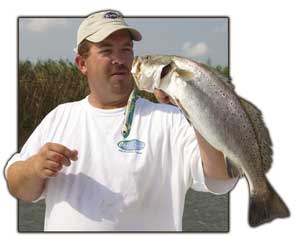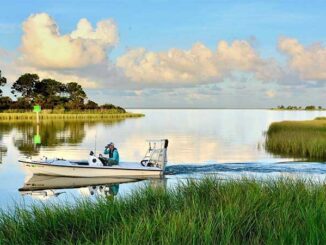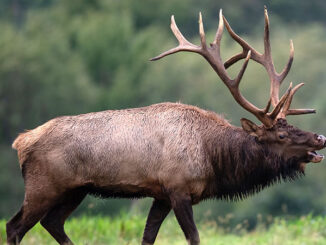
It’s hard to beat the east side of the Mississippi River for the biggest of May’s lunker trout.
I don’t see how any angler who fishes Venice could ever gripe about somebody else being spoiled.
There’s a reason the sign above the steps at Venice Marina reads “Fishing Capital of the World.”
As many anglers know, May is when Venice becomes ground zero for mule trout that are looking for a place to get fat and happy while making a few babies. The fun starts in April and continues through June, but May is the peak of the trophy trout season at the mouth of the Mississippi.
One angler who gets it bad for Venice this time every year is Bret Ferguson from White Castle. Ferguson, better known as Pop on the louisianasportsman.com message boards, isn’t an old man. He came up with his Internet moniker when a neighbor’s lawnmower backfired while he was filling in the online registration form.
Ferguson has learned from many May days on the water that trout love to get over the sandbars off the ends of the passes to spawn. He says trout use the 2- to 3-foot bars the same way Hopedale and DuLarge trout use the oyster reefs. The sow trout get on top of these shallow spots to spawn and gorge on the bait that gets shoved up on the bars.
“I love those bars,” Ferguson said. “They’ll get loaded with mullet and shrimp, and they’ll get loaded with big trout. When I can find one like the one at the bottom of Redfish Bay with water breaking all over it, I know it’s about to be hammer time.”
Capt. Cade Thomas guides at Venice, and he agrees with Ferguson about trout getting stacked on the bars. He fishes them regularly, but he also has a back-up plan in case the river gets a little unruly.
“May is the best month by far to catch big trout at Venice,” said Thomas. “While the bars are great, the fishing goes downhill quickly when the river jumps up to 7 or 8 feet. In that case, I back off to the rigs. It’s all about the salinity of the water. If it’s too salty, their eggs will go to the top and won’t mature. If it isn’t salty enough, they sink to the bottom and won’t mature.”
Ferguson and Thomas focus on the east side of the river during May. The best zone for both is from the sandbar off South Pass to Garden Island Bay through Redfish Bay and up to Dead Woman Pass. There’s a little dead zone between Dead Woman Pass and Baptiste Collette, then it picks up from Baptiste Collette to Taylor Point.
The quality of the trout fishing in this zone is dependent on the rise and fall of the Mississippi River coupled with the intensity of the tide. The volume of muddy water pushing out of the passes when the river gets to 7 or 8 feet puts too much fresh water in the area, and it takes a hard tide to counteract it.
“All that river water tries to shove what I call ‘good fish water’ back to the Gulf,” Ferguson said. “You can hunt and peck to catch some fish in that situation, but the best thing to do is time a trip to catch a hard incoming tide that is shoving in green Gulf water on the bottom. Your current might look like it’s flowing out on top because of the river, but you’ve got to realize that the ‘good fish water’ is shoving in the whole time.”
It takes a good tidal range to make a difference. Ferguson said that a .4 or .6 range just couldn’t do it. He looks for ranges between 1 and 1.9 feet. That kind of range means that even though the water may look ugly on top, it’s perfectly fine on the bottom.
“I like to relate it to what happens at a place like Southwest Pass,” Ferguson said. “You can have water pounding through the rocks down there. But if you throw out a jig on bottom during a hard incoming tide, you’ll see it heading north even though the water is flowing south. That’s what will keep the trout biting if the river is high.”
On the other hand, the lower the river level, the less effect on the fishing because there is less push. If the river is down below 6 feet, you don’t need as much of a tidal range to counteract the fresh water. Ferguson said the fishing is still best on an incoming tide, but it doesn’t have to be as strong. His best advice is to look for that “good fish water.”
“Finding good fish water no matter what the river level can be a little confusing,” Ferguson explained. “When you see your cork floating in water so muddy you could plant wheat in it, it’s hard to imagine that your jig is hanging in green water only 2 feet under the surface. Pay attention to your prop wash from your big engine and your trolling motor. If you’re in good fish water, you’ll see that green water boiling to the surface.”
Other than timing his trips based on the tidal range he needs, Ferguson also tries to time his trips so that he has what he believes to be the best chance at catching a monster trout. Since trout activity peaks on the full moon, he also tries to time his trips to take advantage of this natural cycle.
While an angler is likely to hook an 8-pound trout any day during May, many of the giants are caught three days before and a couple days after the full moon. Ferguson said the cycle is that they gorge themselves three days before, then they focus on spawning when the moon gets there, then they eat heavily because they are starving. This five- to six-day span minus the day of the full moon is what Ferguson believes is the best time to catch a big trout.
“You can hook into a big trout just fishing normally,” he said. “You might hook a couple 6-pounders during a day of fishing with a normal situation.
“But if you want to target the big trout exclusively, you’ve got to get somewhere secluded where boats aren’t running in and out. I look for small trenasses without any oaks coming out of the canes where there isn’t any reason for a boat to run into it. These are little ditches rather than passes that run out into a big bay.”
If you’re looking to catch a limit of trout, Ferguson believes you should stick with a popping cork 100 percent of the time. He sees some applications for tightlining out on the rigs like around Block 69, but against the canes and along the shore it’s purely popping cork.
While just about any piece of plastic will catch fish eventually when hung under a cork, Ferguson has had a lot of success catching trout on a pink DOA. In fact, he said he keeps them in his boat in bulk.
“They are awesome,” he insisted. “You may have to play around with the depth a little bit, but most of the time I put them 22 to 24 inches under my cork. Go deeper if you get in a situation where the green water is farther down. If I have a few people in my boat, we’ll all fish different lengths until somebody starts hammering them, then we’ll all switch to that depth.”
Ferguson has a strong opinion about popping corks, and he believes that all corks are not created equal. He doesn’t have anything but the Old Bayside Paradise Poppers with the concave corks in his boat. With this cork, Ferguson is able to not only get the rattling sound, but he is able to get a bloop, bloop sound as well. It’s a deadly combination that he believes calls in the trout better than any other cork he has ever fished.
And, while he relies mostly on the pink DOA, Ferguson strongly recommends that anglers take along some live shrimp.
“Don’t leave home without them,” he said mimicking an old credit card commercial. “Although I didn’t come up with this saying, I’ve heard a Venice guide or two say that they bite on plastic sometime, but they bite on live shrimp all the time.”
If he wants to target big trout, Ferguson ties on a black/chartreuse MirrOlure She Dog or Top Dog Jr. and fishes it about 20 to 30 feet out in front of the canes. He admitted that any mullet-imitating color like bone would work well, but there seems to be something about that black/yellow color combination that the big trout just love.
As good as the inside areas can be during May, Thomas said there are times when the river will have those areas too messed up to fish effectively. When that happens, he moves out a little and targets the Block 69 and East Bay rigs. These rigs are in depths from 10 to 30 feet, and the best tide to fish the rigs is from no tide at all to just under a foot.
“If you get a range over a foot, the water will be moving through the rigs too fast for you get a bait to the bottom,” Thomas said. “And it seems the timing isn’t nearly as important on the rigs. Some people don’t think those fish are spawning out there, but I kind of think they are. The moon phase is important out there, but I don’t think it’s as important as fishing the shallow areas.”
Thomas said there are a couple of different ways to approach the rigs this month. One of them is to back off the rig about 30 yards on the side that has the most flow pipes. Trout seem to prefer the rigs that have the most pipes, and they congregate on the bottom around the pipes.
Some veteran anglers may have a satellite rig or two that produces for them, but anglers not familiar with the rigs will have better success on the bigger rigs with lots of pipes.
Where fish are positioned in the water column depends on what they’re doing. If they’re feeding, they’ll most often be found either suspended or near the surface. And if they aren’t actively feeding, they’ll be ganged up on the bottom.
Thomas said paying attention to what other anglers are doing around you should help you home in on the depth. If they’re catching on top, then that’s where you need to fish. If they’re all dragging Carolina rigs on bottom, you should do likewise.
“There are big trout on those rigs this time of year,” Thomas said. “You can also catch a lot of fish off them. It wouldn’t be uncommon to catch 40 to 50 trout on the average with two or three in the 6-pound range. And if you catch 50 fish, there’s a great possibility that one of them might be 8- or 9-pounds.”
Thomas targets trophy trout with live croakers fished under a slip cork or on a Carolina rig so he can keep it near the bottom. He believes big trout eat a croaker for the same reason a big spawning bass would eat a bream raiding its bed — just to get rid of it.
When he fishes artificials on the rigs, Thomas most often rigs up a ReAction Taylor’s Eel in black/chartreuse on a 3/8-ounce jighead. He prefers this straight-tail offering because he can bounce it off the bottom or swim it through suspended fish, and the body design of the eel causes it to erratically dart from side to side.
“Sometimes they’ll eat it right when it hits the water,” Thomas said. “If that’s the case, I’ll switch to a Spook or She Dog because that tells me the fish are on the top.”
Thomas also wanted to make sure that anglers fishing the rigs remember they are working rigs with crew boats coming in and out to drop off workers. Please yield if you are in their path, and don’t make them have to go around you. All it takes is one call from the rig to the Coast Guard, and there won’t be any more fishing around that rig for a while.
Ferguson also passed along some friendly advice.
“Catching fish at Venice during May isn’t rocket science,” he said. “But it is a very intimidating place to fish. You’ve got to show a lot of respect for the river while you’re out there with all those bigger boats.
“With that said, though, if I only had one place in Louisiana to fish the rest of my life, there’s no doubt it would be the ‘Fishing Capital of the World.’”

